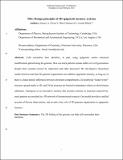Design principles of 3D epigenetic memory systems
Author(s)
Owen, Jeremy A.; Osmanović, Dino; Mirny, Leonid
DownloadOwen_accepted_withfigs.pdf (35.84Mb)
Open Access Policy
Open Access Policy
Creative Commons Attribution-Noncommercial-Share Alike
Terms of use
Metadata
Show full item recordAbstract
<jats:p>Cells remember their identities, in part, by using epigenetic marks—chemical modifications placed along the genome. How can mark patterns remain stable over cell generations despite their constant erosion by replication and other processes? We developed a theoretical model that reveals that three-dimensional (3D) genome organization can stabilize epigenetic memory as long as (i) there is a large density difference between chromatin compartments, (ii) modifying “reader-writer” enzymes spread marks in three dimensions, and (iii) the enzymes are limited in abundance relative to their histone substrates. Analogous to an associative memory that encodes memory in neuronal connectivity, mark patterns are encoded in a 3D network of chromosomal contacts. Our model provides a unified account of diverse observations and reveals a key role of 3D genome organization in epigenetic memory.</jats:p>
Date issued
2023-11-17Department
Massachusetts Institute of Technology. Department of PhysicsJournal
Science
Publisher
American Association for the Advancement of Science (AAAS)
Citation
Owen, Jeremy A., Osmanović, Dino and Mirny, Leonid. 2023. "Design principles of 3D epigenetic memory systems." Science, 382 (6672).
Version: Author's final manuscript
ISSN
0036-8075
1095-9203
Keywords
Multidisciplinary
Collections
The following license files are associated with this item: